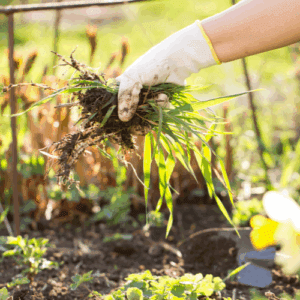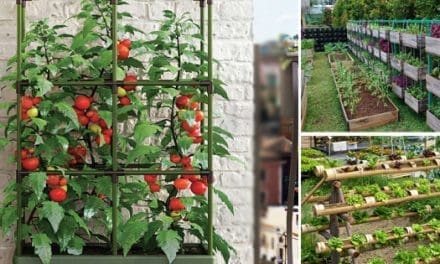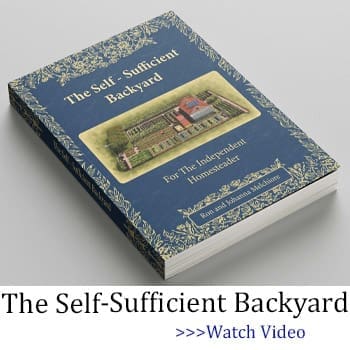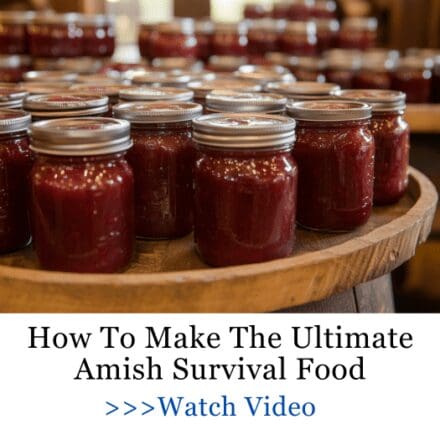There’s no shortage of chemical weed killers that combine various industrial chemicals to kill weeds. One of the primary ingredients in many commercial weed killers is glyphosphate, which has also been known to kill honeybees. But it’s not just about the bees. Many people just don’t like the idea of covering their yards and gardens with harsh chemicals. This is particularly true for anyone growing their own fruits and vegetables.
The unfortunate fact is that many of the fruits and vegetables we buy at the store are literally coated with harsh chemicals from insecticides to fungicides and even residual herbicides. For a lot of us, the solution is to grow our own and keep them organic, and a natural homemade week killer can do just that.
A Few Words of Caution

This isn’t about any dangers to us as it relates to homemade weed killers, but about the possibility that you might kill the flowers, fruits and vegetables you want to keep while you kill the weeds.
The primary thing to do is to localize any organic weed killer to the weed if it’s in a flower or vegetable garden. Spray bottles are the applicator of choice and most have an adjustable nozzle that allows you to either pump out a wide spray or a narrow stream.
If spraying specific weeds in a vegetable garden, it’s best to use a thin stream so you can more accurately aim and direct your organic weed killer at the weed.
A wide spray is best used for a large bed of weeds where no desirable plants are growing.
Another thing to keep in mind is that you may need to use more than one application to kill your weeds. While many of these organic treatments are effective, they’re not as potent as chemical weed killers and you may need to spray a weed 2 or 3 times to kill it. For anyone who wants to keep things organic it’s worth a little extra work.

There are also physical ways to kill weeds from mulch to prevent weed emergence to cornmeal to prevent seed germination. Here again, you have to be judicious because both mulch and cornmeal will prevent all seeds from germinating or emerging, including fruits and vegetables.
It’s also best to apply any organic weed killer in the afternoon long after the morning dew has evaporated. Dry leaves on weeds hold the weed killer better, while wet or moist leaves might cause it to run off.
The biggest mistake people make when using any kind of weed killer is overspray onto flowers, fruits or vegetables you want to keep. If that happens, use a watering can or hose to rinse off the overspray.
The best way to avoid overspray is to avoid treating weeds on windy days, and to use a thin stream of the weed killer pointed straight down onto the weed rather than at an angle.
Natural Weed Killers
Some of the combinations we’ll cover are diluted to varying degrees and others are pure. Which one you use is up to you and over time you may want to experiment to find the one that is most effective.
The type of weed and its maturity also affects results. Purslane is more delicate and will die-off after one application in some instances, while dandelions are tough and usually require 2 or 3 applications.
However, although dandelions may be tough to get rid of, they’re also surprisingly useful in ways you might not expect.
While you’re battling them in the garden, you could also be harvesting them for something entirely different, like a cup of Restorative Liver Tea.
This isn’t just any tea. It’s a powerhouse of natural detoxification. Packed with nutrients that support liver health, it helps cleanse your body, boost your energy and improve digestion, all while being completely free of chemicals. It’s a simple remedy that taps into the very thing most people are trying to pull out of their garden, and turns it into a very powerful ally for your health.
Mature weeds are also tougher to kill due to the fact that their root systems are often well developed giving them some natural resistance to any harsh condition.
The key is to stick with it and to keep applying your organic weed killer until you get results. It also helps to catch them early before their roots get too well developed. With that in mind, here are some organic solutions you can put together, and then we’ll get into physical weed killing possibilities.
Vinegar and Epsom Salt Weed Killer
In order to make a weed killer using dawn epsom salt and vinegar, the easiest way to start is with a clean and empty 1-gallon milk jug. Here are the ingredients and the proportions.
- A full gallon of water in a jug with 2 cups poured out.
- 1 cup of table salt
- 1 cup of household vinegar (5% acetic acid)
- 1 tablespoon of dish soap (Dawn) – helps the solution adhere to the leaves
Vinegar and Epsom Salt Weedkiller Recipe Steps:
- Shake the jug until the salt is dissolved.
- Carefully pour into a spray bottle and apply as needed.
An option to consider is using industrial strength vinegar. This is commonly sold at hardware stores and home centers and is primarily used for cleaning with a 30% dilution of acetic acid. Be particularly careful if using this around fruits or vegetables.
Natural Recipe for Killing Weeds – Pure Lemon Juice
Pure lemon juice is one of the most natural, non-toxic ways to kill weeds, especially for small infestations or in tight garden spaces. This is an easy one.
What You’ll Need:
-
100% pure lemon juice (freshly squeezed or bottled)
-
Spray bottle
How to Use:
-
Pour the lemon juice directly into a spray bottle.
-
On a hot, sunny day, spray the lemon juice generously onto the leaves of the weeds.
-
Make sure to saturate the foliage, especially the center of the plant.
-
You should see the leaves start to brown and curl within 1–2 days.
Water Weed Killer with Rubbing Alcohol
This is another potent solution. It’s mostly water with a dilution of 91% rubbing alcohol. Here’s the recipe:
Ingredients:
- 4 cups of water in a bowl
- 2 tablespoons of 91% rubbing alcohol
Steps:
- Transfer the solution to a spray bottle and apply liberally to dry leaves on a sunny day.
- Here again, avoid overspray onto any plants you want to keep.
Vinegar + Lemon Juice + Water Weed Killer
This is a highly acidic week killer combining acetic acid and citric acid with water. It’s not as strong as any solution containing salt, but salt can actually kill organisms in the ground, so if you want to keep your garden soil healthy you can go with this combination.
Ingredients:

- 1 gallon of water in a jug minus 2 cups
- 1 cup of 5% acetic acid vinegar
- 1 cup of lemon juice
Steps:
- Add the vinegar and lemon juice to the jug of water and mix.
- Pour into a spray bottle and you’re good to go.
Related: Lemon + Baking Soda
Vinegar and Borax Weed Killer
Vinegar and Borax for your weed killer is another potent combination and is best used on weeds along or in a driveway, sidewalk or areas outside of a flower or vegetable garden. It will also kill organisms in the soil, but it is highly effective, especially for those weeds that tend to pop up in those cracks in driveways and sidewalk. Another benefit is that it won’t degrade the surface of concrete the way that salt can.
Ingredients:
- 1 gallon of 5% acetic acid vinegar
- 1 cup of borax
- 1 tablespoon of dish soap
Steps:
- Combine all of the ingredients in a 1-gallon jug and shake until the borax is dissolved.
- Add to a spray bottle and fire away.
Physical Treatments for Killing Weeds
There’s nothing that says you can’t just pull weeds, but there are other physical treatments and approaches. These also need to be used judiciously because they can affect a wide area if used indiscriminately.
1. Boil Water To Keel Weeds
Boiling water will immediately kill any plant. Boil the water in a tea kettle and carefully pour on the weed. It will also penetrate into the soil to kill the roots and even though it may kill some beneficial organisms in the soil, they’ll eventually recover.
2. Cornmeal Weed Killer
Cornmeal is an effective way to prevent germination of weed seeds. Unfortunately, it will inhibit germination of any seeds so it’s best to avoid freshly planted flower, fruit or vegetable seed areas. It’s most commonly used on established lawns and is spread with a handheld spreader.
3. Kill Weeds With Newspapers
This is the way Grandma used to do it. Newspapers spread on the ground will effectively stop germination or at least emergence of weeds. Once again it will also stop any other seed from germinating. Newspapers are best used around established plants, and it really works. The biggest problem is that they tend to be a bit unsightly.
4. Sheet Mulching To Kill Weeds
Maybe the best alternative to newspapers is mulch. This can be wood chips, pieces of bark and even leaves. Mulch is usually spread around established plants about 2-inches thick. It looks much better than newspapers and over time will decompose into the soil.
5. Propane Torch To Kill Weeds
If you really want to bring out the Rambo in you, a blowtorch will kill weeds fast. Home centers actually sell a wand that attaches to a small propane tank with an adjustable nozzle that lets you create a pinpoint flame or a wide burst. Use the pinpoint for weeds in a garden and the wide burst for a large bed of weeds you want to get rid of.
Alternatives: Instead of Killing Weeds, Try These Surprising Uses
While most of us are eager to eradicate them, many of the weeds we battle daily are actually surprisingly versatile. These unwanted plants might just be the solution you never knew you were looking for. So what if, instead of getting straight to the weed killer, you would take a second to note down what weeds you have in your backyard and give them a second chance in your kitchen or medicine cabinet? Here are a few ideas:
The Amish Ibuprofen
They don’t rely on fancy pills, but they sure knew how to deal with pain. For generations, the Amish have turned to some simple backyard weeds, like plantain, for what some now call the “Amish ibuprofen”.
The leaves can be turned into a simple tincture or salve that eases aches and pains without a single lab-made ingredient. Whether it’s sore joints, a headache or muscle tension after a long day in the garden, this homemade alternative might surprise you with how effective it really is.
Herbal Antibiotics, Natural Painkillers & Anti-Inflammatory Tinctures
You’d be amazed at the powerful medicine hiding in plain sight. Many weeds actually have natural antibacterial properties that can help prevent infection in cuts and scrapes, making them ideal ingredients for an herbal antibiotic. Nettles and dandelions, on the other hand, can be steeped into anti-inflammatory tinctures that ease swelling and discomfort from arthritis or overuse. Combined, these weeds cover the spectrum from soothing pain to fighting off infection, and they’ve been doing it long before the first pharmacy ever opened its doors.
Kitchen Staples and Everyday Uses
These wild plants aren’t just good for medicine. They’ve got a place in your kitchen, too.
Some of the most overlooked weeds are actually packed with nutrients and flavor. Dandelion greens add a fresh, slightly bitter bite to salads, while purslane offers a lemony crunch and a surprising dose of Omega-3s. You can brew up nettle or plantain tea for a nourishing herbal tonic, or even turn dandelion flowers into a bright, golden jelly. Chickweed makes a mean pesto, and wild garlic brings any butter or bread to life. These plants might be wild, but they’ve earned a spot in the kitchen.
Assess Your Weeds and Needs
Which approach you use has a lot to do with the weed situation in your yard or garden. It’s also worth experimenting a bit over time and seasons. Hopefully you’ll find a solution that works the best and aligns with your definition of organic. Then again, if all else fails you can always get on your hands and knees and just pull the weeds.
Mole Management: How to Identify Mole Activity and Protect Your Crops
You Can Get Arrested For Growing This Tree. Do You Have It In Your Backyard? (Video)
How Do You Speed Up Composting


















